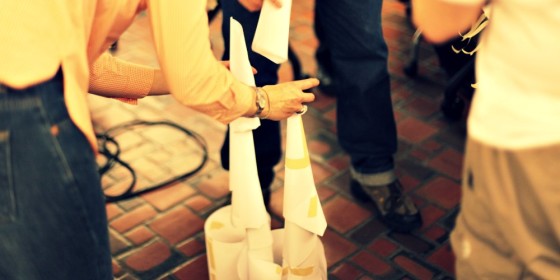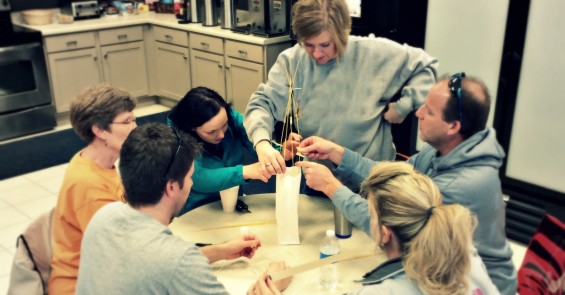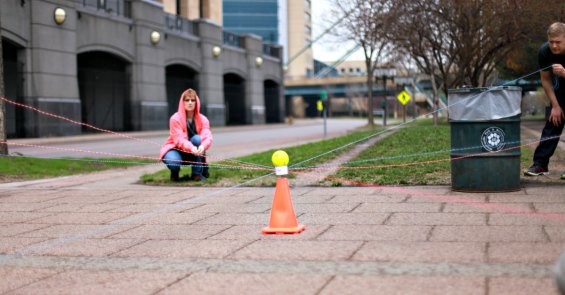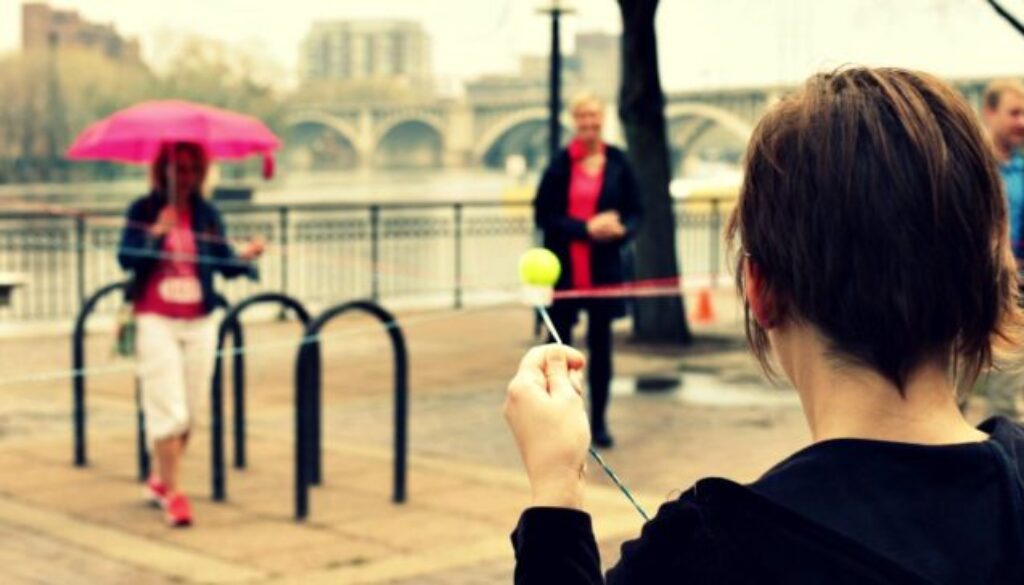3 StrengthsFinder Activities for Teams
Over the past few weeks, we have worked with a couple of different teams who want to become more aware of the individual strengths of the team members, as well as the collective strengths of their team. A great way to do this is through an activity.
The benefits of doing an experiential team activity after providing education around the big ideas of StrengthsFinder are profound. Often, through some seemingly arbitrary task, people instantly have a deeper understanding of how their strengths play out in a team setting. There is something about removing yourself, however briefly, from a “normal” work environment, that brings great clarity.
Once, while we were doing the “Paper Tower” activity (see below for details), one participant commented to another,
I really saw, and now I think I understand more, how your deliberative works. You just sat there for the for first 10 minutes, but then jumped in with a great idea that helped us avoid an obstacle. I now understand that when we’re sitting in meetings, just because you’re silent doesn’t mean you aren’t churning ideas over in your head.
Another time, participants commented on how the self imposed time limit caused them to activate their strengths sooner (in this case Strategic and Ideation). They observed how they don’t feel pressure until there is a looming deadline.
Below are 3 StrengthsFinder activities for teams to complement any strengths teaching. It can be helpful to implement some form of them during a team meeting, or off-site. Feel free to modify or tweak them to suit your needs.
1. The Paper Tower Activity

The objective of the Paper Tower is for teams to build the tallest freestanding tower using only paper and masking tape.
We have written about this activity before as part of something you could do with StrengthsFinder in 60 – 90 minutes. It is mentioned here again because it is such an easy and helpful activity to see strengths.
As the facilitator, you want to observe how participants interact during the planning, construction and debrief phases.
Materials you need to set this up
- A ream of paper or any discarded full sheets of paper from the recycling bin. A group of 20 people may easily use a couple hundred sheets.
- A roll of masking tape for each group.
Instructions
- Divide the larger group into teams of 4 – 6 people each.
- Give each group a roll of tape, and an arbitrary number of sheets of paper.
- Each group has 5 minutes to “design” their structure, but cannot touch the paper or tape during this time.
- Each team has 10 minutes for construction of their tower.
- It is helpful to use a visible timer so all groups can see the time remaining for each portion of this activity. Just Google, “countdown timer” and click on the first one that comes up. It is an excellent one to project on a screen.
- At the conclusion of the activity, allow for 10-15 minutes to debrief as a group. We have provided some general questions to use during the debriefing.
Benefits of this Activity
The paper tower activity easily scales to accommodate almost any size group. It can also be done inside or outside; is quick and provides enough opportunity to see some talent behaviors.
I also like it because there are three distinct phases: planning, executing, and discussion (after you are finished). You will see different people “shine” at different points.
Suggested Debrief Questions
- What did you notice during the planning vs. execution stages?
- Who stood out? Why?
- What obstacles did you run into? How did you deal with them?
- Could you see any strengths at work?
2. The Marshmallow Challenge

The objective of this is activity is for groups to see who can build the tallest, freestanding structure out of spaghetti, string and tape. It differs from the Paper Tower because there are more supplies and one huge requirement… a large marshmallow must be placed on top!
This is perhaps one of my favorite StrengthsFinder activities for teams short on time. I first heard of it from a TedTalk I saw several years ago. Not only is it easy and inexpensive to set up (you can accommodate a group of up to 100 for less than $15), but it is fun and produces some great content for discussion.
Materials you need to set this up
- 20 pieces of uncooked spaghetti noodles per team (not thin)
- 1 yard of kite string per team
- 1 yard of masking tape per team
- 1 paper lunch bag per team
- 1 large marshmallow
Instructions
- Put the uncooked spaghetti noodles, string and marshmallow into the brown paper bag. (It is often easier to give out the tape when they come grab their bag instead of trying to get it in the bag).
- Give one bag to each group
- Give instructions…
- Teams have 18 minutes to build the tallest freestanding structure using only the items in the bag (and also the bag if they choose).
- The marshmallow must be on top!
- Set timer for 18 minutes.
- Start timer – Go!
- Measure towers at the end
- Declare a winner!
- Debrief
Benefits of this Activity
One of the reasons I like it is because it requires collaboration from participants in a short time frame. It is great because it “reveals very deep lessons about the nature of collaboration…” We believe strengths are most alive when generatively engaged on a team. Naturally collaboration is important.
Placing the marshmallow on top without proper support will topple the tower. Most teams wait until the very end to see if it will be able to support the weight. Often, it does not.
When we use this activity, we talk about how building a strengths based culture takes a bit of trial and error. You need to build a little and see how the structure will stand up to outside pressure. It’s ok if it topples. That’s part of the process. Don’t be afraid to experiment and take a few risks.
Suggested Debrief Questions
- What did you notice?
- Who stood out? Why?
- Who seemed to be taking charge? How?
- Could you see any strengths at work? Give examples.
3. Nuclear Disposal

The objective of this StrengthsFinder activity for teams is to transport the “nuclear hot orb” from the “contamination” silo to the “safety” silo. This takes a bit more prep than the others, but is really valuable and provides several levels of behavioral observations.
The following is designed to accommodate a group 5 – 8 people. If you have much more than that, you can either create multiple sets, or just have them take turns.
Materials
Before you start, look at the above picture… that’s what it will look like when you’re done.
- 2 small traffic cones
- 2, 4” PVC couplers (like this)
- 1 tennis ball, 1 softball, 1 small playground ball. You only need all 3 if you are going to make multiple attempts at this activity. Each ball creates a different level of challenge because they are weighted differently.
- 100 ft of 1/4”, nylon rope, cut into 8, 10 – 12 foot lengths.
Setup
This activity will require a bit of “at home” prep. It’s not hard, it will just take you perhaps 30 minutes (once you have all the supplies purchased).
- Drill 8, 1/4″ holes around the outside of the PVC coupler.
- Thread a piece of rope through each hole, tying a knot on the inside of the coupler so it forms a 10’ handle.
- Repeat for each hole.
Instructions
- Place the traffic cone at one end of a “playing field” (can be any location, indoors or out). Place the second one at the other end of the room (distance doesn’t matter). The farther away, the more difficult the challenge. Feel free to place various obstacles in the way if it seems too easy.
- Rest the coupler on top of the traffic cone, with all ropes neatly spread out (or in a tangled mess for added difficulty.
- Rest one of the balls (starting with the lightest first tends to be easiest) on top of the coupler, balancing on the cone.
- Each member of your team must grab one of the ropes attached to the coupler.
- Using only the ropes (no hands allowed), pick up the nuclear hot orb and transport it to the safety silo.
- If orb falls off – start over!
- Participants may not touch any part of the rope except the last 6 inches. It is helpful to tie little knots as a way to indicate.
Benefits of this Activity
This challenge is designed to observe the way team members adapt to changing circumstances. In much the same was as the real world environment can change at a moments notice, this challenge forces participants to flex and adapt with the experience as the facilitator changes the rules/environment as they go.
You will see how people with different strengths approach the idea of flexibility and change.
Suggested Debrief Questions
- How do your strengths enable you to adapt to a changes in your environment?
- How do the actions of another team member (negative or positive) affect your ability to adapt?
- How do you respond when changes in the environment are beyond your control? When they are within your control?
- What strengths could you see at work? Give examples.
Activities you Use
Have you found a helpful activity to highlight the way the strengths of a group work? What additional StrengthsFinder Activities for Teams are both easy to use and show how we can benefit from utilizing everyone on the team? Share them in the comments below.





